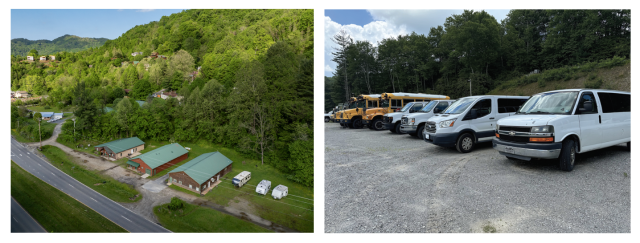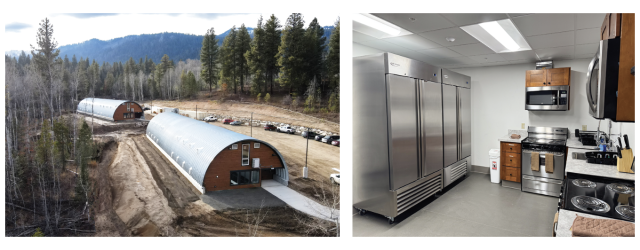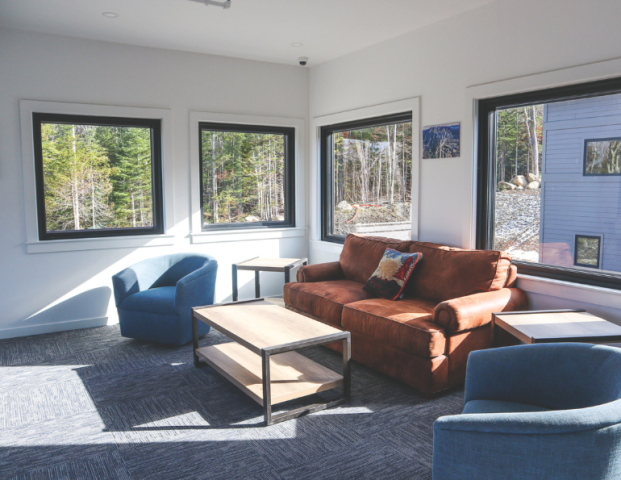As the need for employee housing has morphed from optional to desirable to critical, a growing number of ski resorts have unexpectedly found themselves in the role of landlord. It’s a job that involves a lot more than building apartments and collecting rent.
Faced with a dearth of affordable housing in resort towns, ski resorts across North America have been pouring big bucks into employee housing.
Vail Resorts (VR) has pledged to add more housing as part of a $175 million investment into meeting employee needs. Workers at VR’s Park City Mountain, Utah, can lay their heads in the new Slopeside Village for as little as $400 a month.
Alterra Mountain Company is spending $50 million to house workers at its 17 resorts. As part of that effort, Winter Park, Colo., opened a new 330-bed housing unit in December 2023.
It’s not just happening at the conglomerates, either. Sun Valley, Idaho, added 178 new rooms for employees. Saddleback, Maine, put a cherry on top of its employee housing by making its newest facility ski-in and ski-out, while Tamarack, Idaho, is in the process of building up to 500 worker beds. At Cataloochee, N.C., there’s accommodations for virtually every employee that needs housing.
“Housing here is a nightmare,” says Tamarack housing and recruiting coordinator Skyler Gullickson. “Offering employee housing makes it a bit more affordable. I don’t think Tamarack would be able to operate without it.”
A MAMMOTH TASK
The housing situation at Mammoth Mountain, Calif., illustrates how employee housing needs have evolved. The resort has relied on a mix of owned and rented properties to meet its employee housing needs. “For a long time, we didn’t fill all of our beds,” says Laurey Carlson, a one-time Mammoth ski patroller who is now the resort’s general manager and in charge of employee housing. “As prices rose during the pandemic, it turned out we didn’t have enough units. The crunch started to hit harder, so I got creative.”
By the 2022-23 season, however, Mammoth had a waiting list of more than 80 employees looking for housing, even with up to 500 units available. “We filled everything we had,” Carlson says.
To supplement the resort-owned housing, Carlson reached out to owners of apartments, hotels, motels, and other housing developments, and set up a transportation system that reached as far as the town of Bishop, 45 minutes away. The long commute to work was offset for some workers by the opportunity to enjoy living in the high desert while working in the mountains. Some of those commuters, though, sought to occupy housing closer to the resort when units became available, Carlson says.
Mammoth also eased strain on its housing stock by reducing reliance on J-1 student workers, whose mandated seasonal schedule aligned imperfectly with Mammoth’s needs. “As part of Alterra, we’ve been able to acquire employees from other mountains that close earlier than we do,” she says.
STAFFING UP
Ski areas with a modest stock of employee housing, or that farm out housing to third-party landlords, might be able to get away with utilizing existing staff to run their housing programs. Most, however, need to staff up for the programs, including a dedicated housing manager, housekeeping, and maintenance and janitorial staff.
Cataloochee, which has provided employee housing for more than two decades, has a full-time property manager in its human resources department, and also hires local residents with commercial drivers’ licenses (CDLs)—often school bus drivers—to operate its employee transportation service.
At Tamarack, the employee housing manager’s duties include checking tenants in and out, coordinating maintenance and shuttle operations, and managing resident J-1s and H-2B temporary workers. “We’re basically running a hotel,” says Gullickson. Unlike a traditional landlord, however, the housing manager doesn’t have to chase tenants for rent: that’s done via payroll deduction.
Operators are less likely to hire dedicated, residential advisers (RAs), but typically employ existing staff members as live-in housing staff in return for extra pay or free accommodations.
“We have people in upper management now who started in employee housing 12-14 years ago,” says Cataloochee president Chris Bates. “One upper manager served as an RA for 10 years.”
 Cataloochee (left to right): Drone image of the dorms; The resort uses vans and school buses for its employee transportation service.
Cataloochee (left to right): Drone image of the dorms; The resort uses vans and school buses for its employee transportation service.
IN LOCO PARENTIS
Providing worker housing in ski country carries many responsibilities that often go well beyond typical landlord/tenant relationships.
“What’s most difficult is dealing with employees who are living outside of mom and dad’s house for the first time,” says Gullickson. “They have to do their own dishes, do their own laundry—they can’t leave it in the washing machine for a week.”
“You have to enforce the rules and responsibilities of cleaning up after themselves—that’s been a learning experience for them and us,” says Matt Dieterich, interim CEO and director of real estate development at Saddleback. Adds Carlson: “Some have to be reminded to bathe every day.”
Mammoth even operates a food bank to ensure that employees are “eating more than ramen,” says Carlson. A partnership with a local grocer ensures access to fresh meats and vegetables to young adults and families alike.
Regardless of age, being intimately involved in employees’ home lives is a far different experience than just sending workers home with a paycheck each week. “I think I’ve earned an honorary degree in psychology,” jokes Carlson, who has dealt with everything from housing rule violations and complaints about loud parties at off-site housing to drug overdoses and suicide attempts. Occasionally, fireable offenses take place in and around employee housing, including DUIs and assaults.
Carlson tries to spell out the bottom line for Mammoth employees: “Your housing is dependent on you being a full-time employee. If you lose your job, you lose your job. But if you lose your housing, it’s very hard to keep your job.”
“Sometimes I have to be the boss, other times the counselor,” she says. “I’m a firm believer in our employee-assistance program. The consequences are there, but also the second and third chances.”
DRAFT A STRONG LEASE
The rules for living in employee housing are generally more restrictive than those required of tenants in private apartments and more akin to a college dorm. At Tamarack, for example, employee housing residents must keep their living space clean, observe quiet hours between 10 p.m. and 8 a.m., and allow monthly room inspections (typically aimed at ensuring cleanliness and preventing illicit drug use). Pets are prohibited, and guest visitation is restricted or prohibited depending upon the type of housing unit.
“You need to have a good contract of expectations,” says Bates, who runs a 2-3 hour orientation program for all new employee housing residents before move-in day. “The biggest thing we’ve learned is that housing is a business that’s separate from the ski business. You need regular inspections, once a week in winter, to make sure garbage isn’t piling up and everything is being taken care of. We’ve made the mistake of living with less-than-ideal tenants because they were valuable employees.”
Bates suggests that operators bone up on local landlord-tenant law before diving into the business of employee housing. “If an employee gets fired you can’t just evict them, so you have to frame rents as a discount based on employment,” says Bates, meaning that rates will go up to market level if the tenant doesn’t work for the company anymore.
“Be the authority figure with a firm hand,” advises Gullickson. “Put everything in the lease. Do walkthroughs and have a daily presence. But be flexible—everyone screws up here and there.”
 Tamarack’s employee housing dorms (left) include full kitchens (right).
Tamarack’s employee housing dorms (left) include full kitchens (right).
MEETING DIFFERENT NEEDS
One thing is clear: there’s no “one size fits all” for employee housing.
Tamarack’s two new dorms have 63 units per building, with kitchens on each floor, shared bathrooms with showers, single and double rooms, and common areas with TVs, plus a room for ski and snowboard storage. The resort also offers five cabins for families, and other standalone accommodations for employees with physical or emotional support animals.
Cataloochee has utilized everything from summer camp units to college dorm rooms to house employees; most of the resort-owned housing is dormitory-style, but some middle managers reside in one-bedroom apartments, and a pair of two-bedroom apartments are home to resort snowmakers.
TRANSPORTATION
Getting employees from home to work—and often, from home or work to town and shopping as well—goes hand-in-hand with providing worker housing.
“Transportation is a component of housing and needs to be managed,” says Bates, whose resort operates a fleet of six 12-passenger vans that make regular stops at employee housing, the ski area, tubing hill, and in town.
Even Tamarack, which has all of its employee housing within five minutes of the resort, operates a worker transport network. At Saddleback and other resorts that have J-1 and H-2B workers, providing transportation is a requirement of hiring guest workers, and these transit operations can be adapted to the needs of other employees, too.
MAKING IT FUN
There’s also crossover between the cultural engagement that ski areas must offer to guest workers and activities that enhance the work-life experience of all residents of employee housing.
At Tamarack, monthly employee appreciation events take advantage of the resort’s many activities. Events have included golf scrambles, BBQ & ski events, zip lining, and pontoon boat rides. Saddleback’s cultural engagement programs, which are offered to all employees, have ranged from movie nights and bowling outings to ice fishing.
But for some employees, Saddleback’s biggest draw may be the housing itself, which is located just off trail. “Residents can ski right back to the building,” says Dieterich. “Some employees really value that, others would rather be downtown and close to the bars and restaurants. Understanding who we want in that facility because of the advantages and expectations is really important.”
WORTH THE EFFORT
Providing employee housing clearly isn’t for the faint of heart, but most operators say the business case for a well-run housing facility that meets the needs of both employer and employees is well-constructed.
“Housing is an expense, not a revenue source,” says Bates. “We need it to successfully operate. We charge for it and may cover yearly expenses with rents, but we’ll never recover that capital investment.”
Adds Dieterich: “It’s an investment, but there are benefits to controlling the housing stock.” Previously, he recalls, “finding places for people to live was a full-time job.”
Tamarack, which only allowed employees to occupy staff housing year-round about two years ago, now has a number of workers who have resided in its properties for multiple seasons. “One of the first questions I get from job candidates is do you offer housing,” says Gullickson.
“Year-round permanent staff housing has become a huge need for us,” says Bates, whose operation is located in a rural area lacking both housing stock and a significant local workforce. “A lot come back season after season,” he says. “Twenty-year-old river raft guides are willing to be ski lift attendants in the winter; they just need a place to live.”






